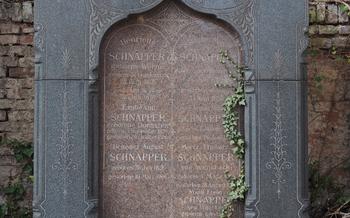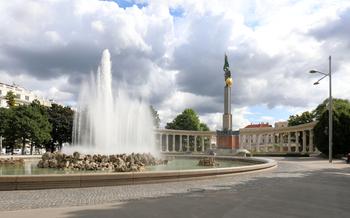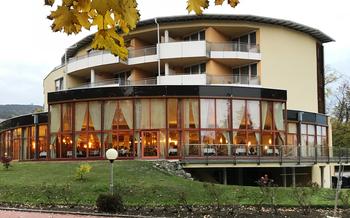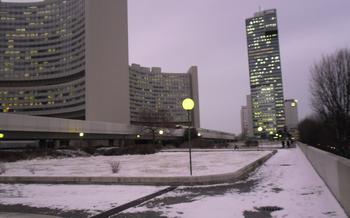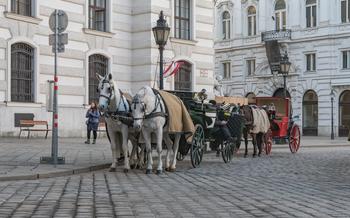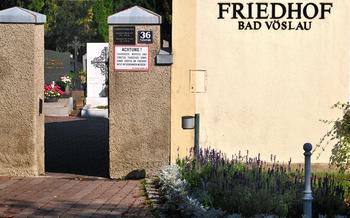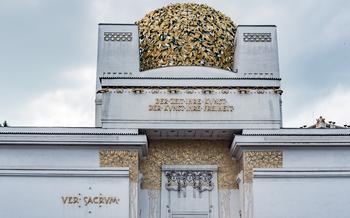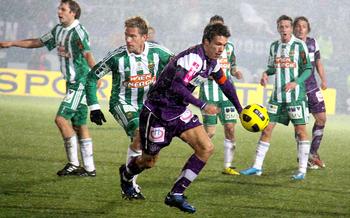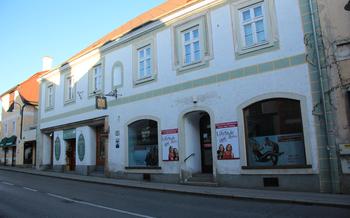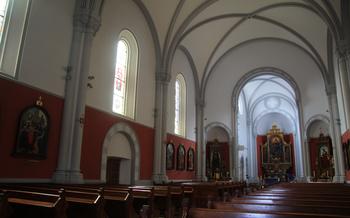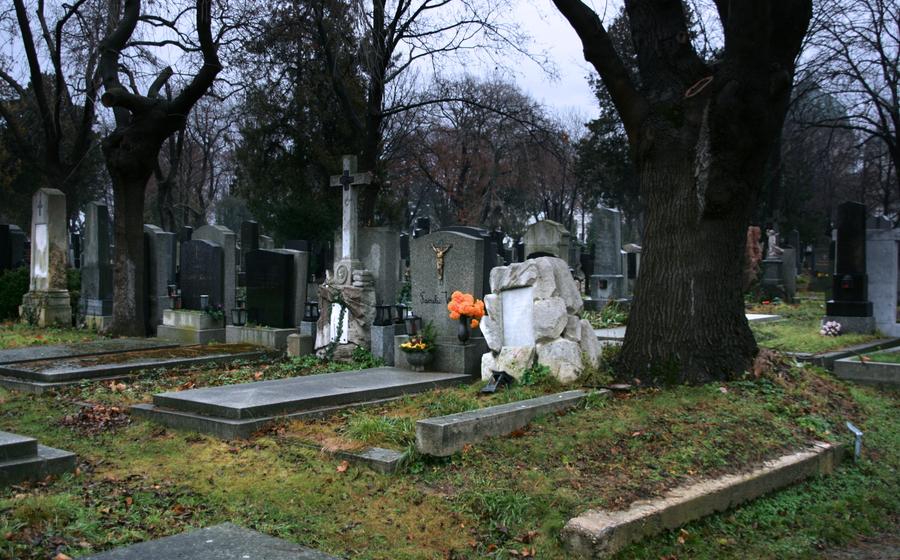
Zentralfriedhof (Central Cemetery)
- Graves of the Famous
- The Strauss Family Crypt
- The Art of Gustav Klimt
- Secessionist Masterpieces
- The War Graves
- The Jewish Section: A Legacy of Resilience and Remembrance
- Unique Epitaphs and Symbolism
- The Funeral Museum
- Guided Tours and Audio Guides
- Respecting Cemetery Etiquette
- Insider Tip: Unveiling Hidden Stories and Legends
Graves of the Famous
The Zentralfriedhof serves as the final resting place for numerous prominent figures from various fields, including music, art, literature, science, and politics. Among the most renowned individuals buried here are:
-
Wolfgang Amadeus Mozart: The legendary composer, widely regarded as one of the greatest musical geniuses of all time, found his final resting place in an unmarked grave in the Zentralfriedhof. His exact burial site remains uncertain, but a memorial stone pays tribute to his legacy.
-
Ludwig van Beethoven: Another musical giant, Beethoven's grave is marked by an imposing monument adorned with his iconic likeness. Visitors can pay their respects to the composer who revolutionized classical music and left an indelible mark on the world of sound.
-
Franz Schubert: A contemporary of Beethoven, Schubert's grave is situated near Mozart's. Despite his relatively short life, Schubert's contributions to music were immense, and his grave serves as a reminder of his enduring impact.
-
Johann Strauss II: The "Waltz King" and one of the most celebrated composers of the Strauss family, Johann Strauss II's grave is marked by an elaborate monument featuring a bronze bust of the composer surrounded by dancing figures. His music continues to captivate audiences worldwide, and his grave is a popular pilgrimage site for music lovers.
-
Gustav Klimt: The renowned Viennese artist, known for his groundbreaking contributions to the Art Nouveau movement, is buried in the Zentralfriedhof. Klimt's grave is adorned with a striking bronze bust that captures his enigmatic persona and artistic brilliance.
The Strauss Family Crypt
In the heart of the Zentralfriedhof lies a monumental crypt that serves as the final resting place of the Strauss family, renowned for their contributions to Viennese music. This magnificent crypt stands as a testament to the family's legacy and profound impact on the world of music.
Designed by the renowned architect Josef Hlávka and completed in 1907, the Strauss family crypt is an architectural masterpiece adorned with intricate carvings, sculptures, and mosaics. The design embodies a blend of classical and Art Nouveau elements, reflecting the eclectic style of the era. Within this grand mausoleum, generations of the Strauss family, including Johann Strauss I, Johann Strauss II, Josef Strauss, and Eduard Strauss, are laid to rest.
Johann Strauss I, the patriarch of the family, was a renowned composer and conductor who revolutionized Viennese dance music. His son, Johann Strauss II, achieved even greater fame, earning the title "Waltz King" for his enchanting melodies and compositions that continue to captivate audiences worldwide. Josef Strauss, another son of Johann Strauss I, was a talented composer and conductor who left an indelible mark on the Viennese musical landscape. Eduard Strauss, the youngest son, carried on the family tradition, composing and conducting memorable waltzes and polkas that delighted Viennese society.
Visiting the Strauss family crypt is a pilgrimage for music lovers and those seeking to pay homage to the giants of Viennese music. The crypt's grandeur and serene atmosphere evoke a sense of awe and respect, allowing visitors to contemplate the remarkable contributions of the Strauss family to the world of music and their enduring legacy in the hearts of music enthusiasts everywhere.
The Art of Gustav Klimt
The Zentralfriedhof is also the final resting place of the renowned Viennese artist Gustav Klimt, whose unique style and contributions to the Art Nouveau movement continue to captivate art enthusiasts worldwide. Klimt's grave, designed by his brother Georg Klimt, stands out amidst the elaborate mausoleums and monuments of the cemetery. The gravestone features a bronze bust of Klimt, created by the sculptor Josef Müllner, atop a simple rectangular base. The bust captures Klimt's intense gaze and melancholic expression, reflecting the artist's introspective nature and his preoccupation with themes of life and death.
The symbolism embedded in Klimt's gravestone further underscores his artistic vision. The bronze bust is encircled by a wreath of intertwined laurel leaves, a symbol of victory and eternal glory. The laurel wreath, a recurring motif in Klimt's paintings, represents the artist's triumph over mortality through his enduring legacy. The gravestone's simple yet elegant design mirrors Klimt's own artistic style, characterized by its blend of opulence and simplicity. By choosing a relatively modest marker, Klimt demonstrated his humility and desire to let his art speak for itself, even in the face of death.
Secessionist Masterpieces
The Zentralfriedhof also serves as the final resting place for several prominent artists associated with the Secessionist movement, a significant artistic movement that emerged in Vienna in the late 19th century. Secessionist artists sought to break away from traditional academic styles and embrace new forms of expression.
Among the notable Secessionist artists buried in the Zentralfriedhof is Gustav Klimt, whose grave is adorned with a striking Secessionist-style headstone. Other Secessionist masters laid to rest here include Otto Wagner, Joseph Maria Olbrich, and Koloman Moser.
Their gravesites feature unique and expressive Secessionist motifs, reflecting the artists' distinct styles and contributions to the movement. These graves not only pay homage to the individuals but also showcase the artistic and cultural significance of the Secessionist movement in Vienna.
The War Graves
The Zentralfriedhof serves as a solemn memorial to the countless victims of war who have found their final resting place within its grounds. A dedicated section of the cemetery is reserved for these war graves, honoring soldiers and civilians who lost their lives in conflicts throughout history.
The war graves are arranged in neat rows, each marked with a simple white cross or headstone bearing the name, rank, and military unit of the deceased. The sheer number of graves, stretching out as far as the eye can see, is a poignant reminder of the devastating toll that war has taken on Austria and its people.
Among the war graves, one can find the final resting places of soldiers from both World Wars, as well as victims of earlier conflicts such as the Napoleonic Wars. Each grave tells a unique story of sacrifice, courage, and loss. Some graves bear the names of young men who never had the chance to experience life beyond the battlefield, while others belong to seasoned veterans who witnessed the horrors of war firsthand.
The war graves section of the Zentralfriedhof stands as a testament to the human cost of war and serves as a reminder of the importance of peace and reconciliation. Visitors can pay their respects to the fallen, reflect on the futility of war, and honor the memory of those who have made the ultimate sacrifice.
The Jewish Section: A Legacy of Resilience and Remembrance
The Jewish section of the Zentralfriedhof holds a profound significance, serving as a testament to the rich history and contributions of the Jewish community in Vienna. Established in 1870, this section encompasses approximately 100,000 graves, each representing a unique story of resilience and remembrance.
Among those buried here are prominent figures who have left an indelible mark on various fields, including arts, sciences, and business. Notable individuals include Bertha Pappenheim, a pioneering feminist and social reformer; Arthur Schnitzler, a renowned playwright and novelist; and Sigmund Freud, the father of psychoanalysis. Their graves, adorned with poignant inscriptions and symbols, pay homage to their extraordinary achievements.
The Jewish section also features a poignant memorial dedicated to the victims of the Holocaust. Unveiled in 1945, this memorial serves as a solemn reminder of the atrocities committed during this dark chapter in history. The memorial's haunting design, featuring shattered tombstones and a menorah, evokes a sense of profound grief and remembrance.
Visiting the Jewish section of the Zentralfriedhof is a deeply moving experience, offering insights into the rich history and resilience of the Jewish community in Vienna. It is a place where one can pay respects to those who have made significant contributions to society and reflect on the enduring legacy of the Jewish people.
Unique Epitaphs and Symbolism
The Zentralfriedhof is a treasure trove of unique epitaphs and symbolism, offering a glimpse into the lives, beliefs, and values of those buried here. From heartfelt expressions of love and loss to witty remarks and profound philosophical musings, the gravestones tell their own stories.
One of the most striking epitaphs is found on the grave of composer Franz Schubert: "Here lies music." This simple yet powerful statement captures the essence of Schubert's life and legacy, reducing his vast contributions to the world of music to a single, poignant phrase.
Another notable epitaph belongs to actor Hans Moser: "I'm not here." This playful and enigmatic inscription leaves visitors wondering about its intended meaning. Is it a joke, a philosophical statement, or a reference to Moser's enduring presence in the hearts of his fans?
Symbolism also plays a significant role in the Zentralfriedhof's epitaphs. Many graves feature intricate carvings and sculptures that convey deep meanings and emotions. Angels, cherubs, and other religious figures represent the hope of eternal life and divine protection. Broken columns symbolize interrupted lives cut short by death. Weeping willows and other funerary motifs evoke feelings of sorrow and loss.
Exploring the epitaphs and symbolism of the Zentralfriedhof is like embarking on a journey through history, culture, and human experience. These inscriptions offer a fascinating glimpse into the minds and hearts of those who have passed on, leaving behind a lasting legacy in stone.
The Funeral Museum
In addition to exploring the gravesites, visitors can delve deeper into the history and traditions of Viennese funerals at the Funeral Museum, located within the Zentralfriedhof. This unique museum offers a fascinating glimpse into the diverse cultural and religious practices surrounding death and burial in Austria.
The museum's exhibits showcase a collection of artifacts and displays that illustrate the evolution of funeral customs over the centuries. Visitors can learn about the different types of coffins and burial rituals, as well as the symbolism and significance of various funeral objects. Interactive displays and educational resources provide an engaging and informative experience for visitors of all ages.
The Funeral Museum offers a valuable opportunity to gain insights into the cultural and historical significance of death and mourning in Vienna. It complements the experience of visiting the Zentralfriedhof, providing a deeper understanding of the stories and traditions that lie behind the gravestones.
Guided Tours and Audio Guides
Exploring the Zentralfriedhof with a knowledgeable guide can greatly enhance your experience. Guided tours are available in various languages and provide insights into the history, architecture, and notable gravesites of the cemetery. These tours typically cover the highlights of the cemetery, including the graves of Mozart, Beethoven, Schubert, and other famous personalities.
Audio guides offer a flexible alternative for self-guided exploration. With an audio guide, you can set your own pace and choose which graves and monuments to visit. Audio guides provide detailed information and commentary on the most significant sights, allowing you to learn about the lives and legacies of the people buried here.
Whether you opt for a guided tour or an audio guide, make sure to plan your route in advance. The Zentralfriedhof is vast, and it's easy to get lost or miss important landmarks. A map or a smartphone app can help you navigate the cemetery and find the graves you want to visit.
Respecting Cemetery Etiquette
The Zentralfriedhof is not merely a tourist attraction; it is also a place of mourning and remembrance for the families and friends of those interred within its grounds. As visitors, it is essential to be mindful of the solemnity of the site and conduct ourselves with respect. Proper attire is expected, with shorts, tank tops, and revealing clothing generally discouraged. Maintaining silence and avoiding loud conversations helps preserve the tranquil atmosphere. Photography is permitted, but it is crucial to be discreet and not intrude upon the privacy of mourners or take photos that could be seen as disrespectful. Refrain from touching or leaning on gravestones, as they may be fragile or have special significance to the deceased's loved ones. By adhering to these guidelines, we can ensure that the Zentralfriedhof remains a place of peace, remembrance, and respect for all who visit.
Insider Tip: Unveiling Hidden Stories and Legends
Beyond the well-known graves of celebrities, the Zentralfriedhof holds many hidden gems and untold stories waiting to be discovered. Venture off the beaten path to uncover the resting places of lesser-known but equally fascinating individuals. Discover the grave of Karl Lueger, the controversial mayor of Vienna who shaped the city's political landscape in the early 20th century. Or pay your respects to the victims of the Mayerling incident, a tragic love story that ended in a double suicide involving Crown Prince Rudolf of Austria.
Unearth the legends that shroud the cemetery. Seek out the grave of Helene Odilon, an actress whose spirit is said to roam the grounds, forever searching for her lost love. Listen for the haunting melodies that emanate from the grave of Franz Schubert, believed to be the disembodied echoes of his unfinished compositions.
The Zentralfriedhof is a treasure trove of hidden stories and legends, just waiting to be explored. Embrace the mystery and intrigue as you delve deeper into the cemetery's rich history and uncover its untold tales.
